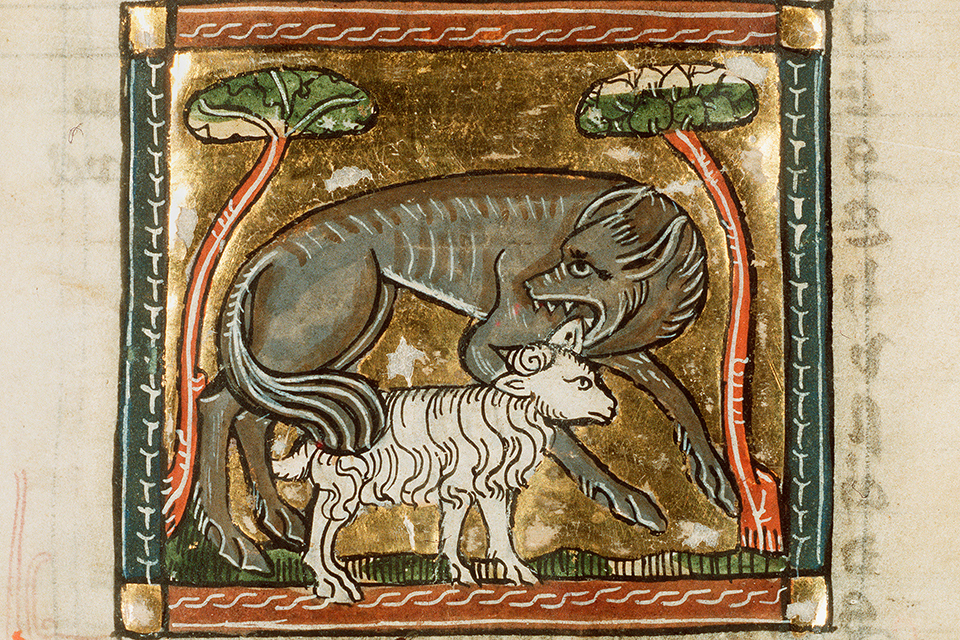Roman and Germanic people revered the wolf in Late Antiquity and the early Middle Ages. So why did a pernicious hate of one of Europe’s remaining predators supersede the veneration in the Early Middle Ages?
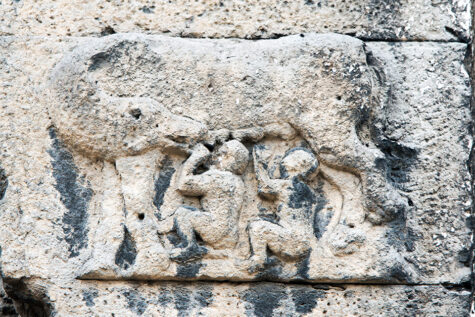
In the Roman Empire, the story was told of how the twins, Romulus and Remus, were suckled by the Capitoline wolf. Later, they founded the Eternal City on the Palatine and Aventine Hills, nourishing a rich mythical and artistic legacy. This suckling wolf may be found on coins from the 3rd century BC and the following 600 years. Without a doubt, the wolf had a special place in the Roman imagination.
Although a serious threat to smaller grazing animals, the wolf was never considered a demonic beast but rather a part of the natural order. As such, the Roman shepherds defended themselves and their flocks with the help of large white dogs equipped with spiked collars. Columella wrote that white dogs were preferable because they were easily distinguished from the grey pelts of the predators. Another method was to tie a bleating lamb in a dug-out pit, luring the wolf to its grave, where it might be bludgeoned to death. In general, though, wolves were not regarded as dangerous to men. Thus, Horace wrote a poem about a wolf who fled from him in the wilderness beyond his farm in the Sabine woody mountains. Neither were wolves hunted for their meat or their pelt, and bears and serpents offered more medicinal options. Finally, the Romans do not appear to have hunted wolves for pleasure. One reason may be that the wolf is challenging to hunt with a spear or a bow and arrows, thus offering no particular sport as opposed to bears, hares and other herbivores. The paucity of archaeological remains also witnesses to this Roman attitude toward wolves. Therefore, they were not introduced into the arena where all sorts of predators roamed to kill prisoners subjected to this fate. Nor do wolves seem to have been kept in the small zoos, vivaria, which the elite created as part of their sumptuous villas.
It appears, the fate of wolves differed from all the other top predators used in the Roman arenas and spectacles. Based on this evidence, Mika Rissanen (2014) has suggested that there might have been a taboo among Romans against hunting wolves.

Christianity
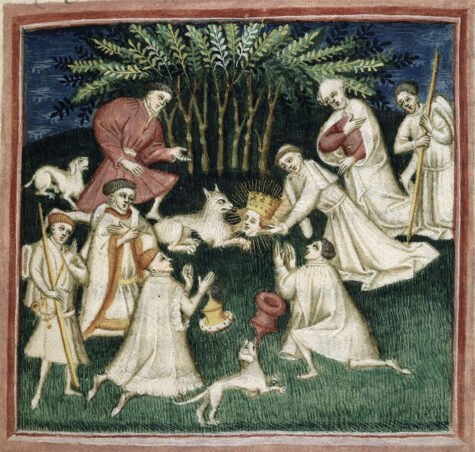
However, this changed with the advent of Christianity and the proliferation of the stories told about Christ as the good shepherd, protecting his herd. Now, the wolf was diabolically coupled with the devil and enhanced with its fame as an animal able to devour whole flocks of sheep. As such, the wolf was singled out as a common metaphor in both the Old and the New Testaments for the heretic, the false prophet and the devil.
Noteworthy, also, was the Christian concern with speech as the defining attribute of people (as opposed to animals) and the corresponding notion that wolves might steal a person’s communicative skills. This myth about the “Lupus in the Fabula” was known in Antiquity from the writings of, among others, Terence, Cicero, Plautus, and Plinius. St. Ambrose of Milan repeated this idea, thus lifting the motif into the writings of Isidore (560–636). He wrote: “To the situation, as in “the wolf in the story”: peasants say that a person would lose his voice if he saw a wolf in front of him. Thus, the proverb, “the wolf in the story,” is said to someone who suddenly falls silent. (Isidore: Etymologies I:xxxvii,27 [1]).
Following Isidore, Hrabanus Maurus (780–856) conveyed this superstitious story in his De Rerum Naturis in Book 8, 1:
Others call them wolves and say they are like lions because, like a lion, the wolf has strength in his feet, whence whatever he presses with his foot does not live. And seeking blood, he is a ravenous beast, of which the peasants say that he will destroy a man if the wolf sees him first. Whence it is said that the man falls suddenly silent: The wolf in the fable…The wolf, therefore, is rarely found to have good intentions but often the opposite.
(Transl. from: De Rerum Naturis, Book 8, nr. 1).
However, the clergy also preached that wolves might be tamed. Thus, we hear about the wolfish Danes, who tried to silence their opponent, the English King, Edmund the Martyr, in AD 869 by killing him. However, as is told in the later vita, to silence him, the Wolfish Danes had to cut off his head and throw it into a thick forest. From here, though, the decapitated head called out to the men searching for him. According to the legend, they found his head cradled in the lap of a speech-protecting wolf (Passio Sancti Eadmundi).
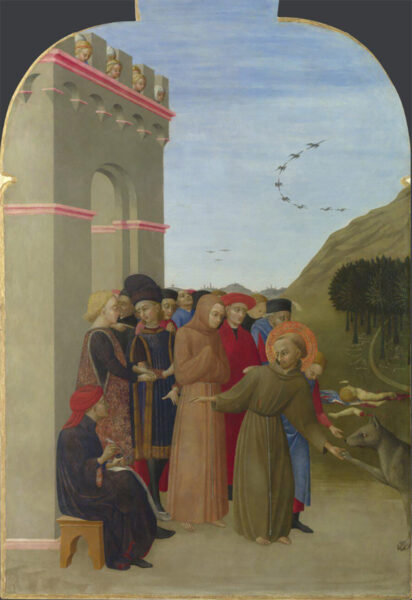
Such fabled “domesticated” wolves were not uncommon. Another example is known from the legend of the Wolf from Gubbio in Italy, in which St. Francis tamed a wolf which had been attacking livestock and humans for several years. Gubbio felt under siege as no one dared venture outside the walls. Finally, though, the saint took it upon himself to seek the animal in its lair. Here, he made the sign of the cross and commanded the wolf to cease his attacks, to which the wolf docilely acquiesced, after which he entered into a peaceful pact with Francis. Afterwards, the pair entered the city of Gubbio to preach at the centre of the town. There, with the tame wolf at his feet, Francis was quoted as saying: “How much we ought to dread the jaws of hell if the jaws of so small an animal as a wolf can make a whole city tremble through fear?” The story goes on to tell that the wolf lived peacefully in the town feeding from scraps offered by the citizens.
Unfortunately, the story of the wolf from Gubbio does not present us with its broader context. However, we know Umbria and the rest of central Italy after 1197 was enmeshed in a civil war fought between a series of Holy Roman Emperors, numerous factions, independent cities and the Popes creating a war-torn and violated countryside characterised by bands of mercenaries roaming from skirmish to skirmish. Well known is the story of how dreams of chivalry lured Francis of Assisi to sign up as a soldier to end up in a harsh prison, and also, how these experiences were catalysts for his later “career” as a saint. Likely, the story of the Wolf from Gubbio must be read as both an allegory and a story reflecting reality.
The fact is that wolves moving around through devastated and dead landscapes littered with rotting corpses may turn into occasional scavengers.
Occasional Scavengers
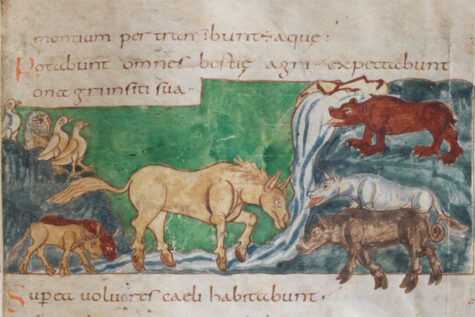
In AD 842, the Carolingian Empire splintered when the three grandsons of Charlemagne fought at the Battle of Fontenoy. In the aftermath, an otherwise unknown Engelbert wrote a lament describing how the dead lay naked while vultures, crows and wolves devoured their flesh. Here we meet the wolf as one of the threesome Beast of Battle, the eagle, the raven and the wolf – the occasional scavengers roaming the battlefields of yesteryear (Engelbert at the Battle at Fontenay [2]).
A few years later, this ferocious animal moved west, where it arrived in 846 to attack and devour “with complete audacity the inhabitants of Western Gaul. Indeed, in some parts of Aquitaine, they were said to gather together in groups of up to 300, where they “just like army detachments” formed a sort of battle-line and marched along the road, boldly charging en masse all who tried to resist them” (The Annals of St. Bertin [3]). Likely, the wolfs here were a blended mass of Vikings and real wolves following in the path of the pirates and marauders, devastating the countryside of Northern France and England at this time.
A series of studies carried out in France and Belgium have shown how these and other anecdotal references have merit. Historical sources make it clear that the wolves actively sought the European Battlefields in Medieval and Early Modern Europe. However, they also seemed to flourish in numbers whenever rich pickings were offered on the battlegrounds. The sources documenting these matters may be found in the accounts of towns where bounties were offered and paid out. However, another ecologically founded explanation may be that wolves were better able to reproduce in war zones emptied of people who had fled to the nearest cities. Also, in wartime, men were more likely to be engaged as soldiers and not wolf-hunters, which required a concerted effort of digging pits, maintaining nets, keeping packs of wolf-hounds, sourcing cattle for bait etc. Nevertheless, the linkage between a growth in populations of wolves and war has been demonstrated during the Hundred Years’ War in France (1337-1453), the Thirty Years’ War in Germany (1618-1648), and Cromwell’s invasion of Ireland (1649-1653).

The most controversial part of this debate, though, is the linkage between the wolf as an occasional scavenger, its recourse to rotting corpses and the claim that wolves in this manner acquire the taste of human flesh, leading to them actively hunting for humans. This complex question has been studied by the French historian jean-Marc Moriceau, who has trawled through nearly 5500 instances of mortalities registered as being the victims of either predatory or rabid wolves between 1571 and 1890. His studies have shown that people were particularly vulnerable during the end of the French Wars of Religion, 1596-1600 and again in the middle of the 17th century. For instance, only eight victims of predatory wolves were counted between 1611 and 1630; and then suddenly growing more than ten times to 106 during the next decade. This growth might be compared to the rate of rabid attacks, which only doubled. Also, these attacks were concentrated in specific regions in France, with most attacks detected in 9 out of 118 departments. These nine departments accounted for more than 56% of the registered predatory attacks and may be grouped into three regions, one west of Paris, one surrounding Lyons and finally, some south of the Auvergne. As opposed to this, the attacks perpetrated by rabid wolves seem much less concentrated. As rabies is a random illness, it is, above all, linked to the density of wolves. Accordingly, the predatory attacks are not just a reflection of the density of wolf populations but rather their correlation with war zones and battlefields. Moriceau writes, “The temporal distribution of attacks shows a recurring link with armed conflict, particularly at the end or in the aftermath of civil or foreign wars, when higher numbers of corpses were left unburied. The link is very clear for the Wars of Religion at the end of the sixteenth century and in the aftermath of the Fronde in the mid-seventeenth century”.
Forest, Deers and Wolves
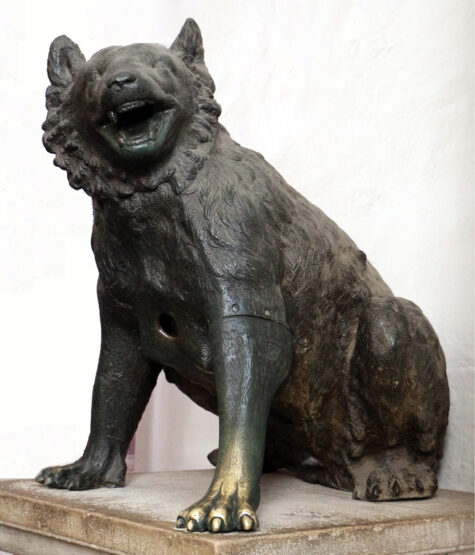
Finally, the role of hunting as an elite pastime played a significant role in casting the wolf as the bestial enemy.
Throughout the Middle Ages, hunting was the chief pastime of the elite – whether kings, warriors and nobles. Hunting was essential to constantly hone military skills and maintain a certain level of fitness. Also, it was an essential part of training young boys at court, introducing them to the camaraderie of happy hunting excursions and the manly culture involved in the formation of strategies, the reading of landscapes, the wielding of the weapons and the training of dogs, falcons and hawks. All leading up to the breaking of the game and the fabulous feast where the drinking horns were emptied, and the poets praised the events of the day.
At the centre of these noble rituals were well-stocked forests filled with games. At the time of the Carolingians, such forests were increasingly established as privileged hunting grounds for the kings and their nobles. We read about these forests forged out of communal woodland while severely restricting the peasants’ traditional hunting practices by snares, nets, pits and otherwise. A later decree from Italy indicates that Charlemagne may have intended to limit any peasant-hunting of “our game”. As part of this set of rules, efforts were launched to exterminate wolves and bears. Thus, Charlemagne commanded every village major throughout his kingdom to appoint two full-time wolf-hunters called Luparii. Exempt from military service and legal duties, they were paid by the local freemen. The skins were to be sent to the court. Hunting methods were poison, traps, pits, and dogs and should occur in May when litters were born. “Protecting the crown’s game in royal forests was the chief motivation behind Charlemagne’s program to exterminate wolves, although an added benefit was that it protected the livestock of nearby villages. It also compensated for the outlawing of public trapping, which previously had been the chief strategy for controlling wolf populations,” we read in Eric Goldberg’s study of Frankish hunting .
In AD 813, bishop Frothar of Toul (813¬–847) wrote a letter to Charlemagne boasting of his efforts in this direction. The letter reads: Although it is not yet time for me to give a complete account of my efforts, I would like to provide your Majesty with an interim report on how I have done in exterminating these terrestrial wolves. Since you granted me the diocese, I have killed 240 wolves in your forests. I say, “I have killed them” because they were captured on my orders and command”.[4]. With the size of the diocese of Toul covering perhaps 525.000 ha, this cull represented one wolf pr ca. 2000 ha. This number may be compared to the present situation in France, where 640 animals were counted in June 2022.
With the Carolingians, the cordoning off of medieval deer parks and forests took off. Together with this establishment of the privileged hunt followed the corresponding efforts to exterminate the wolf, the competitor par excellence. May we even claim, Charlemagne was responsible for the hate of wolves? Today, the status and camaraderie of hunting may no longer belong to the elite. Rather, it has evolved into a pastime enjoyed in the rural hinterlands.
However, perhaps the faint echo of the medieval culture of hunting may be found lurking behind the coveted licenses to kill wolves which haunts the rural communities of present-day wilder Europe?
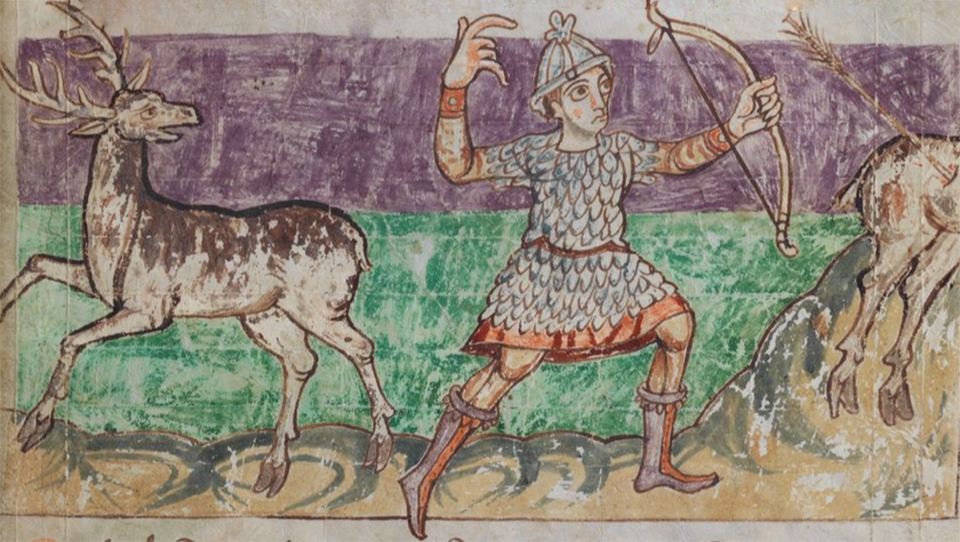
FOOTNOTES:
[1 The Etymologies of Isidore of Seville. Ed. And translated by Stephen A. Barney, W. J. Lewis, J. A. Beach, Oliver Berghof with the collaboration of Muriel Hall. Cambridge University Press 2016, p.63
[2] Engelbert at the Battle of Fonteney. In: Carolingian Civilisation. A Reader. Ed. by Paul Edward Dutton. Broadview Press 1993, p. 363
[3] The Annals of St-Bertin, trans. J.L. Nelson (Manchester, 1991).
[4] As quoted in Goldberg, 2020, p 202.
FEATURED PHOTO:
Wolf devouring a lamb from: Der Naturen Bloeme by Jacob van Maerlant. Manuscript from Royal Library in Holland. KB KA 16 062 r. Source: Wikipedia
SOURCES:
Was there a taboo on Killing Wolves in Rome?
By Mika Rissanen
In Quaderni Urbinati di Cultura Classica (2014)Nuova serie, Vol 107 No. 2 pp 125-147
Published by: Fabrizio Serra Editore
Lupus in Fabula
By Kenneth M. Abbott
In The Classical Journal (1956) Vo 52 No 3 pp 117-122
The History of the Wolf in Western Civilization: From Antiquity to the Middle Ages
By Malcolm Drew Donalson
Edwin Mellen 2006
In the Manner of the Franks. Hunting, Kingship, and Masculinity in Early Medieval Europe.
By Eric J. Goldberg
University of Pennsylvania Press 2020
Wolves and Warfare in the History of the Low Countries, 1000-1800
By Sander Govaerts
In: Low Countries Historical Review (2022) Vol 137-1 pp 4-27
A Debated Issue in the History of People and Wild Animals. The Wolf Threat in France from the Middle Ages to the Twentieth Century, 2014
By Jean-Marc Moriceau
Man and Wolf: 2000 Years of History
Website organised by Jean-Marc Moriceau
